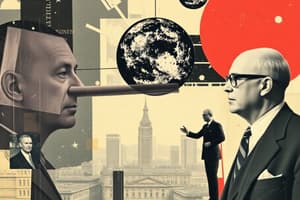Podcast
Questions and Answers
What does Business Acumen mean?
What does Business Acumen mean?
Possessing the knowledge, abilities, and skills to succeed in the business field.
Which of the following is NOT a goal of Business Acumen?
Which of the following is NOT a goal of Business Acumen?
- Obtain a deep understanding of company's visions and missions
- Applying IT and general technology
- Understanding business laws (correct)
- Develop business strategies and goals
What is a goal in the context of Business Acumen?
What is a goal in the context of Business Acumen?
A statement of general, broad, long-term target, aim, and intent.
What is included in Tactical Goals?
What is included in Tactical Goals?
Which of the following is a component of Porter's Five Forces Model?
Which of the following is a component of Porter's Five Forces Model?
What does the Threat of Substitutes refer to?
What does the Threat of Substitutes refer to?
What are Operational Goals characterized by?
What are Operational Goals characterized by?
Vision is a statement that reflects management’s values and beliefs.
Vision is a statement that reflects management’s values and beliefs.
Flashcards are hidden until you start studying
Study Notes
CIA Integrated Review Overview
- The CIA Integrated Review includes courses like Business Acumen and Strategic Management for the 1st Semester of SY 2024-2025.
Monday Motivation
- Quote by John Wooden: "Things work out best for those who make the best of how things work out."
Business Acumen
- Defined as the knowledge, abilities, and skills (KASs) needed for success in business.
- Objectives for CIAs in Business Acumen:
- Understand company visions and missions deeply.
- Develop effective business strategies and goals.
- Comprehend core business functions.
- Apply information technology and general tech effectively.
- Solve business issues and assist in decision-making.
Strategic Planning
- Strategies provide a macro view of the organization’s direction and the processes senior management uses to create and implement strategies.
Mission and Vision
- Mission statements encapsulate management’s values and beliefs.
- Vision statements outline the desired future state and aspirations of the company.
Goals
- Goals arise from the vision and mission, serving as broad, long-term objectives for the organization.
Tactical Goals
- Connected to strategic goals, these include measurable medium-term outcomes.
- Example goals:
- Add 1,000 branches in the Philippines.
- Achieve inclusion in the Top 1,000 Corporations in the Philippines.
Operational Goals
- Focused on short-term, specific measurable results for individual work groups.
- Example goals:
- Generate 15% additional sales.
- Reduce employee turnover by 50%.
Planning and Actions
- Plans act as blueprints detailing necessary resources, schedules, and actions to reach goals.
- Actions are structured steps taken to implement plans and generate expected results.
Porter’s Five Forces Model
- A strategic analysis framework by Michael Porter introduced in 1979 to analyze market competition and profitability.
Competitive Rivalry
- Intensity influenced by:
- Number of competitors.
- Industry growth rate.
- Similarity of products/services.
- Exit barriers.
- Fixed cost levels.
Threat of New Entrants
- Factors affecting potential new competition:
- Economies of scale.
- Product differentiation.
- Required capital investment.
- Access to distribution channels.
- Regulatory barriers.
Bargaining Power of Suppliers
- Strong supplier power can increase costs or limit resources.
- Influenced by:
- Number of available suppliers.
- Uniqueness of supply.
- Importance of the supplier industry.
Bargaining Power of Customers
- High customer power pressurizes businesses to offer better products/services at lower prices.
- Intensified by:
- Number of buyers.
- Size of transactions.
- Price sensitivity.
- Customer awareness.
Threat of Substitutes
- Availability of alternatives poses a significant threat to industry players.
- Magnifying factors include:
- Relative price-performance ratio.
- Customer inclination towards substitutes.
- Perception of product similarity.
- Access to close substitutes.
Michael Porter’s Generic Strategies
- A firm’s competitive positioning within the industry significantly influences its profitability levels.
Studying That Suits You
Use AI to generate personalized quizzes and flashcards to suit your learning preferences.




